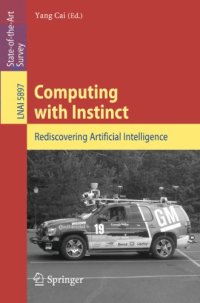
Ebook: Computing with Instinct: Rediscovering Artificial Intelligence
Author: Kevin Warwick Slawomir J. Nasuto Victor M. Becerra Benjamin J. Whalley (auth.) Yang Cai (eds.)
- Tags: User Interfaces and Human Computer Interaction, Artificial Intelligence (incl. Robotics), Simulation and Modeling, Computation by Abstract Devices, Computers and Society, Developmental Biology
- Series: Lecture Notes in Computer Science 5897 Lecture Notes in Artificial Intelligence
- Year: 2011
- Publisher: Springer-Verlag Berlin Heidelberg
- Edition: 1
- Language: English
- pdf
Simplicity in nature is the ultimate sophistication. The world's magnificence has been enriched by the inner drive of instincts, the profound drive of our everyday life. Instinct is an inherited behavior that responds to environmental stimuli. Instinctive computing is a computational simulation of biological and cognitive instincts, which influence how we see, feel, appear, think and act. If we want a computer to be genuinely secure, intelligent, and to interact naturally with us, we must give computers the ability to recognize, understand, and even to have primitive instincts.
This book, Computing with Instincts, comprises the proceedings of the Instinctive Computing Workshop held at Carnegie Mellon University in the summer of 2009. It is the first state-of-the-art survey on this subject. The book consists of three parts: Instinctive Sensing, Communication and Environments, including new experiments with in vitro biological neurons for the control of mobile robots, instinctive sound recognition, texture vision, visual abstraction, genre in cultures, human interaction with virtual world, intuitive interfaces, exploitive interaction, and agents for smart environments.
Simplicity in nature is the ultimate sophistication. The world's magnificence has been enriched by the inner drive of instincts, the profound drive of our everyday life. Instinct is an inherited behavior that responds to environmental stimuli. Instinctive computing is a computational simulation of biological and cognitive instincts, which influence how we see, feel, appear, think and act. If we want a computer to be genuinely secure, intelligent, and to interact naturally with us, we must give computers the ability to recognize, understand, and even to have primitive instincts. This book, Computing with Instincts, comprises the proceedings of the Instinctive Computing Workshop held at Carnegie Mellon University in the summer of 2009. It is the first state-of-the-art survey on this subject. The book consists of three parts: Instinctive Sensing, Communication and Environments, including new experiments with in vitro biological neurons for the control of mobile robots, instinctive sound recognition, texture vision, visual abstraction, genre in cultures, human interaction with virtual world, intuitive interfaces, exploitive interaction, and agents for smart environments.